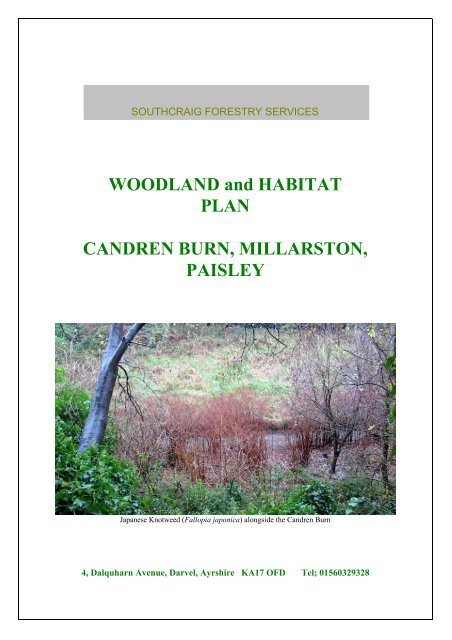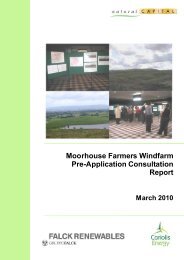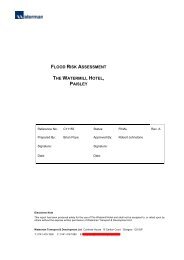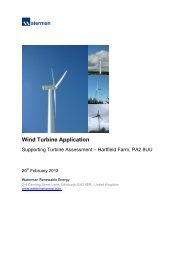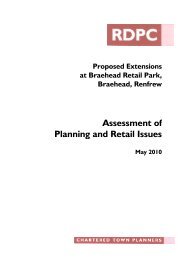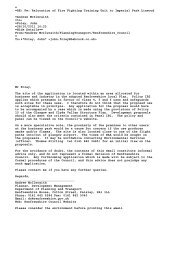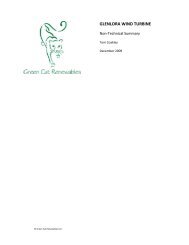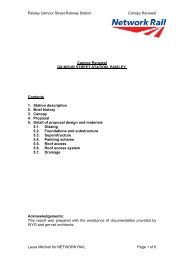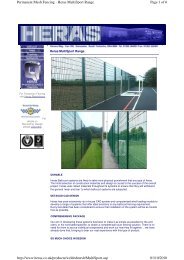WOODLAND and HABITAT PLAN CANDREN BURN, MILLARSTON ...
WOODLAND and HABITAT PLAN CANDREN BURN, MILLARSTON ...
WOODLAND and HABITAT PLAN CANDREN BURN, MILLARSTON ...
You also want an ePaper? Increase the reach of your titles
YUMPU automatically turns print PDFs into web optimized ePapers that Google loves.
SOUTHCRAIG FORESTRY SERVICES<br />
<strong>WOODLAND</strong> <strong>and</strong> <strong>HABITAT</strong><br />
<strong>PLAN</strong><br />
<strong>CANDREN</strong> <strong>BURN</strong>, <strong>MILLARSTON</strong>,<br />
PAISLEY<br />
Japanese Knotweed (Fallopia japonica) alongside the C<strong>and</strong>ren Burn<br />
4, Dalquharn Avenue, Darvel, Ayrshire KA17 OFD Tel; 01560329328
<strong>WOODLAND</strong> / WILDLIFE <strong>HABITAT</strong> SURVEY AND <strong>PLAN</strong><br />
CONTENTS<br />
1.<br />
2.<br />
3.<br />
4.<br />
5.<br />
6.<br />
7.<br />
<strong>CANDREN</strong> <strong>BURN</strong>, <strong>MILLARSTON</strong>, PAISLEY<br />
General description of the area.<br />
Survey of woodl<strong>and</strong> habitat.<br />
List of trees <strong>and</strong> plants identified on site.<br />
Management Plan - Years 1 to 3<br />
Management Plan - Years 3 to 5<br />
Management Plan - going forward.<br />
Plan of areas.
General<br />
<br />
<br />
<br />
<br />
<br />
<br />
<br />
<br />
Survey<br />
<strong>WOODLAND</strong> / WILDLIFE <strong>HABITAT</strong> SURVEY AND <strong>PLAN</strong><br />
Description<br />
<strong>CANDREN</strong> <strong>BURN</strong>, <strong>MILLARSTON</strong>,PAISLEY<br />
The survey was a ground level visual survey completed on the 19 th<br />
November 2009. The weather was wet with average temperatures <strong>and</strong><br />
light wind. The survey was completed to inform a long-term<br />
management plan.<br />
Location - The section of banking along the north side of C<strong>and</strong>ren Burn starting at<br />
Map Reference: NS 461 633 <strong>and</strong> finishing at NS 464 634.<br />
Aspect - South facing.<br />
Soil Type - Gleyed Brown Earth.<br />
The L<strong>and</strong> - A narrow strip of steeply sloping bank, 12metres wide at the narrow<br />
point <strong>and</strong> 35 metres wide at the wide point, lying on the north side of<br />
the side of the Burn. The l<strong>and</strong> is in an urban setting, with existing<br />
housing on the south side, <strong>and</strong> proposed housing on the north side. The<br />
strip, contributes to a corridor of green space that stretches out to the<br />
Gleniffer Braes.<br />
The Burn - The section of C<strong>and</strong>ren Burn that forms the south boundary of the<br />
proposed development is mesotrophic in character. It represents the<br />
outfall from an adjacent man made body of water, which has an<br />
associated l<strong>and</strong>scaped open space.<br />
Appearance - The area has the appearance of a semi-natural woodl<strong>and</strong>. The inclusion<br />
of non-native <strong>and</strong> exotic plants has significantly downgraded the<br />
woodl<strong>and</strong> <strong>and</strong> habitat.
Woodl<strong>and</strong> / Habitat Survey<br />
The survey area was divided into sections 1 – 5, the sections are loosely based on changes<br />
occurring in the habitat along the burn. Descriptions of each section follow, a plan is attached<br />
to assist with identification of the boundaries.<br />
Area 1<br />
The Bank<br />
The upper story (8 – 10m high) consists of an intimate mixture of young <strong>and</strong> semi-mature<br />
Goat Willow (Salix caprea), Ash (Fraxinus excelsior), Oak (Quercus robur), with Hawthorn<br />
(Crataegus monogyna) reaching maturity, growing densely at the top of the bank <strong>and</strong> in<br />
mixture throughout.<br />
The under story consists of occasional Holly (Ilex aquafolium) <strong>and</strong> Wild Raspberry (Rubus<br />
idaeus).<br />
Ground cover is light on the bank with Fern (Dryopteris ssp.) <strong>and</strong> patches of mixed grasses<br />
with Japanese Knotweed (Fallopia japonica) growing densely along the burn <strong>and</strong> lightly on<br />
the bank.<br />
Flat area (Area 1A)<br />
This was to originally be a SUDS pond, now moved elsewhere, it is identified as sub-area 1A.<br />
The upper story (4 – 5m high) is young densely stocked Birch (Betula pubescens), with no<br />
under story <strong>and</strong> a ground cover of mixed grasses mainly Cocksfoot (Dactylis glomerata) <strong>and</strong><br />
Japanese Knotweed (Fallopia japonica).<br />
Area 2<br />
Almost exclusively Japanese Knotweed (Fallopia japonica). There is no upper story <strong>and</strong> little<br />
other ground cover.<br />
Area 3<br />
The upper story has a very fragmented canopy of Elder (Sambucus nigra), Goat Willow<br />
(Salix caprea), Ash (Fraxinus excelsiori) (14 –15m tall) <strong>and</strong> Sycamore (Acer pseudoplatanus)<br />
(14 – 15m tall).<br />
The under story is dense Bramble (Rubus fruticosus) with Japanese Knotweed (Fallopia<br />
japonica) along the burnside.<br />
Ground cover, where it occurs is Ivy (Hedera helix), the Ivy has also colonised many of the<br />
trees.
Area 4<br />
The upper story (14 – 15m high) has a variable density of canopy consisting of Elder<br />
(Sambucus nigra), Goat Willow (Salix caprea), Ash (Fraxinus excelsior), Sycamore (Acer<br />
pseudoplatanus) <strong>and</strong> Crack Willow (Salix fragilis).<br />
Beneath the closed canopy Ivy has almost completely colonised the ground <strong>and</strong> many of the<br />
trees.<br />
The under story is dominated by Bramble (Rubus fruticosus) <strong>and</strong> Wild Raspberry (Rubus<br />
idiaeus) where the Ivy is lightest. Along the burnside Japanese Knotweed (Fallopia<br />
japonica) dominates.<br />
Where the ground is free of Ivy, the ground cover is more diverse than in areas 1, 2 <strong>and</strong> 3.<br />
Outside the canopy <strong>and</strong> amongst the Bramble <strong>and</strong> Wild Raspberry, Common Nettle (Urtica<br />
dioica), Creeping Buttercup (Ranunculus repens), Queen of the Meadow (Spiraea ulmaria),<br />
Fern (Dryopteris spp.), mixed grasses <strong>and</strong> Broadleaf Plantain (Plantago major L) are growing<br />
<strong>and</strong> thriving.<br />
Along the burnside <strong>and</strong> occasionally further up the bank Japanese Knotweed (Fallopia<br />
japonica) is growing vigorously.<br />
Area 5<br />
Area 5 has an upper story (14 – 15m high) of Elder (Sambucus nigra), Goat Willow (Salix<br />
caprea), Ash (Fraxinus excelsior), Sycamore (Acer pseudoplatanus) <strong>and</strong> Crack Willow (Salix<br />
fragilis).<br />
The trees are well spaced <strong>and</strong> the canopy light <strong>and</strong> Ivy is not so dominant. Bramble <strong>and</strong> Wild<br />
Raspberry, Common Nettle (Urtica dioica), Creeping Buttercup (Ranunculus repens), Queen<br />
of the Meadow (Spiraea ulmaria), Fern (Dryopteris spp.), mixed grasses <strong>and</strong> Broadleaf<br />
Plantain (Plantago major L) are all present with the addition of Rosebay Willow Herb<br />
(Chamerion angustifolium).<br />
Along the burnside <strong>and</strong> occasionally further up the bank Japanese Knotweed (Fallopia<br />
japonica) is growing vigorously.<br />
Conclusion<br />
The site, as woodl<strong>and</strong>, is in a derelict state, it appears to be approx 30 –40 years old. As a<br />
habitat, the diversity of tree species <strong>and</strong> uneven age <strong>and</strong> density is advantageous. The lack of<br />
management has left a limited under story <strong>and</strong> impoverished ground cover. The extensive<br />
invasion of Japanese Knotweed is a major problem, which will have to be addressed quickly.<br />
The trees <strong>and</strong> vegetation are stabilising a very steeply sloping bank, this stabilisation is<br />
important for the development site <strong>and</strong> integrity of the burn. It is important therefore to make<br />
changes to the habitat slowly.<br />
The 1.8 metre high wood fence which is proposed along rear of the development, under
consideration, will exclude all access to the woodl<strong>and</strong>, this has the advantage of improving the<br />
likely-hood of wildlife activity within it. It also reduces the risk of falls <strong>and</strong> injury down the<br />
steep bank <strong>and</strong> into the burn for members of the public <strong>and</strong> children in particular.<br />
MANAGEMENT <strong>PLAN</strong> FOR <strong>WOODLAND</strong> <strong>HABITAT</strong>.<br />
Years 1 to 3<br />
The trees proposed for removal along the top of the bank, should be felled into the site <strong>and</strong><br />
removed, the stumps ground out, <strong>and</strong> voids filled. No other work should be started until a<br />
temporary or permanent fence, has been erected along the entire length of the woodl<strong>and</strong> to<br />
prevent any damage to the habitat or contamination of the C<strong>and</strong>ren Burn, during the site<br />
development.<br />
To protect the habitat from further deterioration, a programme of Japanese Knotweed<br />
eradication should be started, using Glyphoste. A license from SEPA will be required for this<br />
due to the proximity of the C<strong>and</strong>ren Burn. The eradication programme will take 2 – 3<br />
growing seasons. The spraying programme should be extended to include removal of Ground<br />
Ivy from rings within Areas 3 <strong>and</strong> 4. Once the rings are clear Oak <strong>and</strong> Holly plants can be<br />
established.<br />
Any broken limbs, dead or dying trees should be felled <strong>and</strong> the timber <strong>and</strong> branches stacked in<br />
wildlife piles within the woodl<strong>and</strong>, <strong>and</strong> above the floodplain.<br />
The Birch in Area 1A requires thinned, the spaces created can then be planted with Alder <strong>and</strong><br />
Crack Willow. This will stabilise the floodplain <strong>and</strong> provide a more diverse mix. Willow close<br />
to the burn will provide an improved fish habitat.<br />
The overhang from the Willow, <strong>and</strong> the dense undisturbed waterside, with hopefully improved<br />
fish <strong>and</strong> aquatic stocks, may encourage Otters into the area. This, is unlikely to happen until<br />
the Burn starts to run cleaner than at present, finding Spraints is likely to be the first evidence<br />
of the arrival of Otters into the area. If it becomes apparent Otters are using the area, it may be<br />
advantageous, to prevail on the Roads Dept to provide a ledge inside the culvert that lies<br />
between this area <strong>and</strong> the remainder of the upstream corridor.<br />
Years 3 to 5<br />
Check eradication of Japanese Knotweed, inspect eradication sites for new species. If no<br />
useful species are present, start planting programme.<br />
The cleared Japanese Knotweed areas along the burnside should be seeded <strong>and</strong> planted with<br />
the following.<br />
6 groups of 9 Crack Willow (Salix fragilis)<br />
6 groups of 9 Dogwood ( Cornus sanguinea)<br />
3 groups of 15 Yellow Flag Iris (Iris pseudacorus) Within sight of Station Road.
This planting should be followed by seeding with a woodl<strong>and</strong> edge mix, at a rate of 4 g sq/m<br />
The mix we recommend for this site is supplied by - Habitat Aid Ltd., The Old Rectory,<br />
Lamyatt, Somerset BA4 6NH.<br />
A Woodl<strong>and</strong> Edge seed mix<br />
This mixture is a specially selected mixture of grasses <strong>and</strong> wild native woodl<strong>and</strong> flowers that<br />
will bloom in spring <strong>and</strong> early summer. It needs some shade. Please note that this mix includes<br />
poisonous Digitalis. The bluebells in the mix are native, not Spanish, <strong>and</strong> harvested under<br />
DEFRA licence in our supplier's own woodl<strong>and</strong>20% native wildflower seed <strong>and</strong> 80% native<br />
wild grasses.<br />
% Wildflowers (by weight)<br />
2.0 Agrimony Agrimonia eupatoria<br />
2.0 Garlic Mustard Alliaria petiolata<br />
0.5 Ramsons Allium ursinum<br />
0.5 Wild Angelica Angelica sylvestris<br />
0.5 Nettle-leaved Bellflower Campanula trachelium<br />
1.0 Foxglove Digitalis purpurea<br />
1.0 Teasel Dipsacus fullonum<br />
1.0 Meadowsweet Filipendula ulmaria<br />
1.0 Hedge Bedstraw Galium mollugo<br />
1.0 Wood Avens Geum urbanum<br />
0.5 Bluebell Hyacynthoides non-scripta<br />
1.0 Perforate St. John’s-wort Hypericum perforatum<br />
1.0 Selfheal Prunella vulgaris<br />
2.0 Red Campion Silene dioica<br />
1.0 Betony Stachys officinalis<br />
1.0 Greater Stitchwort Stellarea holostea<br />
1.0 Upright Hedge-parsley Torilis japonica<br />
2.0 Wood False-brome Brachypodium sylvaticum<br />
% Grasses<br />
80.0 Park Meadow Grass Mix<br />
Over time, the existing plants, particularly Bramble <strong>and</strong> Rosebay Willow Herb can be expected<br />
to colonise this area. Although this will help blur the edges of the planting, the density of this<br />
invasion will require control.<br />
Year 5 onwards<br />
<br />
<br />
<br />
<br />
Carry out tree husb<strong>and</strong>ry works as required on a 5 year cycle.<br />
Maintain checks for Japanese Knotweed, spray out any reoccurrence annually,<br />
Maintain approximate species balance by cutting or spraying on a 3 year cycle.<br />
Remove litter <strong>and</strong> tipping on an annual basis.
Check site for nests or Otter activity before cutting or spraying.<br />
1-A<br />
Area 1 Area 2 Area 3<br />
<strong>WOODLAND</strong> AND <strong>HABITAT</strong> SURVEY - <strong>CANDREN</strong> <strong>BURN</strong>,<strong>MILLARSTON</strong><br />
Woodl<strong>and</strong> compartmented <strong>and</strong> sub-compartmented to identify habitat changes<br />
Area 1 Area 1 - A<br />
Trees<br />
Salix caprea Betula pubecens<br />
Crataegus monogyna<br />
Fraxinous excelsior<br />
Quercus robur<br />
Ilex aquafolium<br />
Vegetation<br />
Rubus idaeus Dactylis glomerata<br />
Dryopteris ssp. Fallopia japonica<br />
C:\Documents <strong>and</strong> Settings\Dick\My Documents\OBrian\http maps.renfrewshire.gov.pdf<br />
Area 2<br />
Trees<br />
None<br />
Vegetation<br />
Fallopia japonica<br />
Area 3<br />
Area 4<br />
Trees<br />
Sambucus nigra<br />
Salix caprea Fraxinus<br />
excelcior Acer<br />
pseudoplatanus<br />
Vegetation Rubus<br />
fruticosus Fallopia<br />
japonica Hedera<br />
helix<br />
Area 4<br />
Area 5<br />
Trees<br />
Sambucus nigra<br />
Fraxinus excelsior<br />
Salix caprea<br />
Salix fragilis<br />
Acer pseudoplatanus<br />
SOUTH<br />
20th No<br />
Vegetaion<br />
Rubus fruticosus Rubus idaeus<br />
Hedera helix Urtica dioica<br />
Fallopia jaoponica Ranunculus r<br />
Dryopteris ssp. Spiraea ulmar
1 of 1


